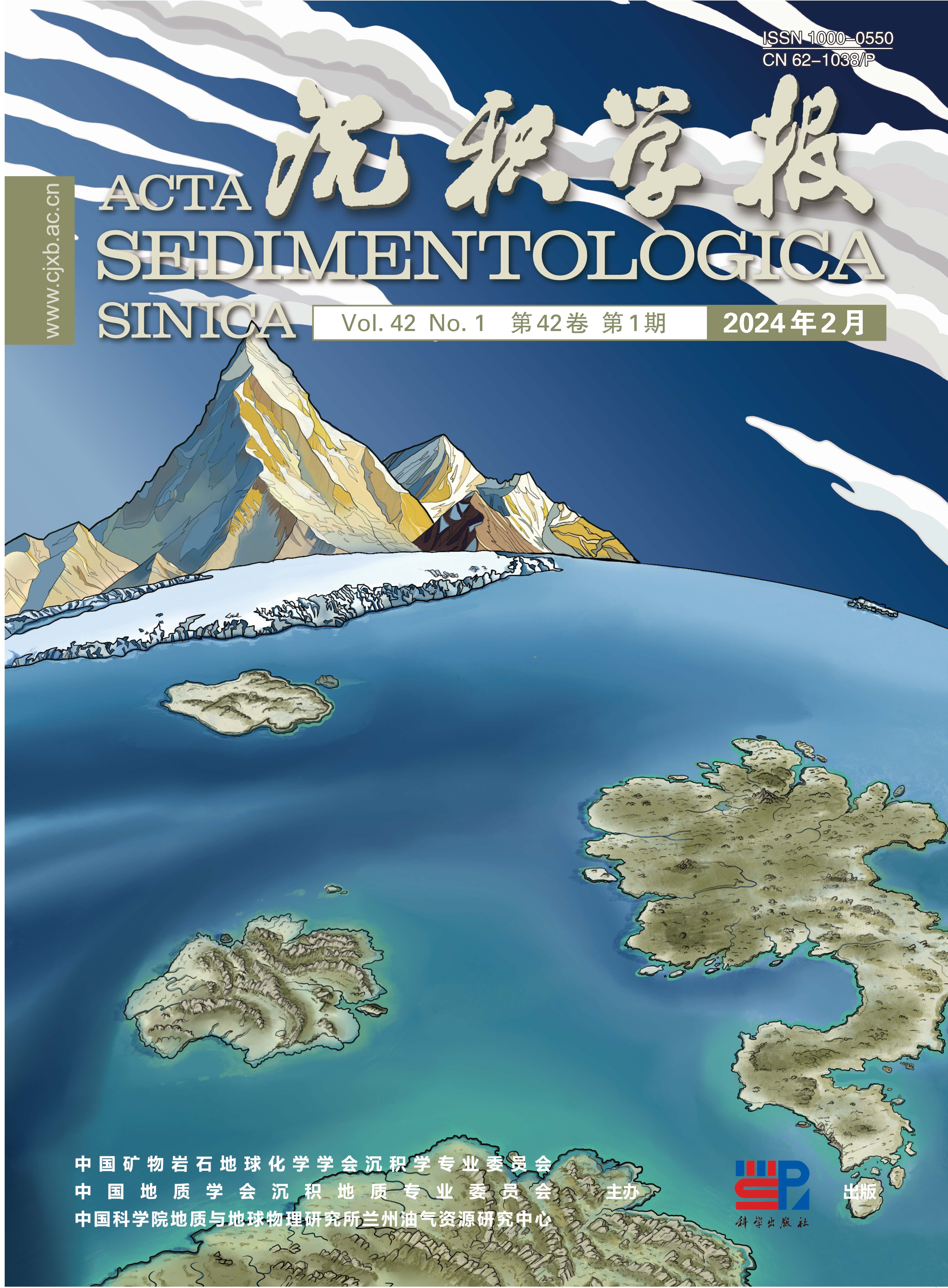HTML
-
自20世纪60年代起,人类对火星的探测从未间断,并在火星沉积学、地形地貌、物质成分、水环境等方面有所进展[1],随着天问一号在乌托邦平原的成功着陆,我国的火星探测也进入了新的历史阶段。
水活动历史和沉积体系演化一直是火星研究的中心主题,而且二者通常相互关联。许多研究表明火星上具有丰富的沉积历史、水环境历史、古生命迹象等[2⁃5]。在火星的后期演化中,其水分和大气逐渐逸失,导致火星气候干燥、温度下降、大气稀薄[6],氧化作用、水活动和化学风化随之减弱,最终使火星早期沉积演化的产物更容易保存下来[7]。这为通过沉积学研究推测火星水活动提供了可能[8⁃9]。
目前,大多数研究者通过遥感探测、光谱成像、卫星图像等技术对火星水活动历史和沉积体系进行研究[10⁃14]。来自火星陨石的同位素证据和来自大气测绘数据的解释表明,火星在Noachian早期(大约在4 100 Ma之前)可能存在一个全球地表水水库[15]。McCubbin et al.[16]和Hurowitz et al.[17]对火星上的含水岩浆作用探究发现,含水岩浆活动可能是古代地表水的重要来源。有大量的地貌学和矿物学证据表明早期火星上存在液态流体,但其性质可能与地球上的水不同。Fukushi et al.[18]通过对Gale陨石坑内环形山湖泊沉积物进行分析,证实了早期Gale湖水的高盐度性,并认为火星表面流体偏酸性,碳酸盐矿物的选择性溶解广泛存在。同时,沉积体系研究也是水活动历史研究的一部分[19⁃20]。许多研究者推测火星上大量沟壑地形,特别是火星南部高地的数百个沟谷网络,是由液态水所冲蚀而成[21⁃25]。而火星上不断被发现的类似地球的三角洲、冲积扇和河道沉积也是地表水曾经存在的重要依据[26]。美国航空航天局的“机遇号”曾在Meridiani平原发现了层状沉积岩,Squyres et al.[14]的研究表明这种层状沉积岩是由水侵蚀产生的硅酸盐、硫酸盐、赤铁矿等物质构成。Morgan et al.[12]在研究火星Saheki陨石坑冲积扇时发现,Saheki扇中的大部分层状沉积物由漫滩沉积和浅水湖泊沉积的细沉积物组成。
综上,众多学者通过对火星上沉积物和沉积岩的研究,均推测火星在地质历史中存在较为活跃的水环境,并且改变了火星上的大量岩石[11]。但是,对火星上地表水的规模、流量、降水量等定量参数缺乏有效的研究手段。
2016年,Birch et al.[27]通过研究土星最大的卫星——土卫六上冲积扇和河流扇的形成与分布,推断了河道径流量对扇体演变的影响,并且将扇形沉积体的沉积特征与地球上相似的沉积体进行了对比。与地球相比,火星的质量、重力加速度较小(火星上的重力加速度为3.71 m/s2,仅为地球上的37.9%)。火星与地球在重力加速度方面存在差异,而重力对水流作用和沉积物运移均有影响[28]。在低重力环境下,火星的水流作用变弱,颗粒运动和悬浮所需的剪切应力值也降低。因此,火星和地球在沉积物运移能力上差异不大[29]。这为通过沉积体系研究火星地表水活动提供了一个思路,也可以进一步论证地外行星存在水的证据以及恢复其古沉积环境等[21]。河流扇的概念是在冲积扇的研究中逐渐演化和分离出来的。Schumm[30]于1977年在The Fluvial System一书中将河流作用引入具有稳定流体供给的扇形沉积体中,是河流扇概念的基本雏形。2020年,河流扇被定义为一种发育在山口或平原地带,内部以河流沉积作用为主,在地质时间尺度上形成沿上游顶点向下游区域发散的扇状沉积体[31]。相较于观测火星上的冲积扇,河流扇具有更大的面积和更稳定的河道供给。这些特征使其比冲积扇更容易观测。而且,沉积过程的相对稳定也使得通过河流扇研究水活动历史成为了可能。
通过建立地球河流扇数据集和扇体预测模型,对火星河流扇进行识别和分析,进而定量推测火星局部区域的地表水径流量及其来源。该研究将为进一步深入研究火星地表水活动提供一个新的方法。
-
现代河流扇沉积的识别和数据采集主要利用美国谷歌公司的卫星图片。通过对世界范围内的河流扇进行识别和全方位测量,建立包含河流扇形成和发育信息的数据集。
对全球范围的河流扇识别,主要分三个步骤:首先,对全球河流进行检索,标定山区季节性河流和常年稳定性河流,筛选出河流扇最有可能发育的区域。其次,在筛选出的区域进行河流扇的初次判别。判别标准如下:(1)上游方向有稳定的水道供给,在某一点(顶点)向下游方向呈放射状展布,形成扇形沉积体;(2)海拔高度自顶点向河道下游方向下降;(3)从顶点往下游方向没有其他支流汇入;(4)终止于陆地(盐湖、湿地、末端干涸),终止于轴向河流,或终止于稳定水体(湖泊、海洋)。最后,需要对识别出的扇体进行复核确认,并根据河流扇的发育背景和沉积特点,把冲积扇、三角洲等相类似的沉积体排除[31]。
采集的数据主要包含平面发育要素数据和控制因素数据两大类。
平面发育要素数据主要包括河流扇长度、宽度、面积、内部河道形态及末端终止类型。长度是指扇体的顶端至扇端边缘的距离;宽度是二分之一长度处的扇体宽度中值;面积包含活动的扇体面积和废弃部分的面积;扇体类型是根据扇体是否发育受限划分;河道样式是指扇体内部的河道形态;终止类型主要是终止于陆地、轴向河流或稳定水体。
控制因素数据是指不依赖于扇体本身的各类环境参数。我们录入了7种控制因素数据。盆地类型数据是通过美国地质调查局发布的全球盆地分布图确定;气候类型数据和降雨量数据通过美国气象局公布的全球气候分布带和全球降雨量分布确定;经纬度、坡度、集水区面积和扇体至山前距离数据则是通过谷歌地图内的定位、测距、测高和测量面积这四个功能采集,数据类型及单位见表1。
控制因素数据 平面发育数据 垂向发育数据 盆地类型 前陆盆地、裂谷盆地等 外部扇体类型 限制型扇体等 构型单元类型 深切河道、废弃河道等 气候类型 干旱气候、半干旱气候等 内部河道样式 顺直河、辫状河等 岩相单元类型 块状砾岩、块状砂岩 经度/纬度 (W/E)°/(N/S)° 终止类型 末端终止等 叠置关系 界面级次、接触关系 坡度 度 扇体长度 千米 单元位置 扇根、扇中、扇端 集水区面积 平方千米 扇体宽度 千米 单元厚度 米 年平均降雨量 毫米 扇体面积 平方千米 单元长度 米 扇体至山前距离 千米 长宽比 — 单元宽度 米 -
通过采集到的数据,发现全球河流扇分布具有明显的纬度分带特征。大多数扇体发育在中纬度地区。在北半球,河流扇集中在30°~50° N纬度带(49.5%),在南半球集中在15°~35° S纬度带(21.9%),这两个纬度带发育了全球(71.4%)的河流扇(图1)。
此外,河流扇在不同的气候、盆地类型下的分布也存在明显差异。河流扇主要分布在半干旱和干旱气候条件下,分别占统计样本总量的68.4%和14.4%。热带季风气候下也较为常见,为8.4%,其他气候下发育的河流扇相对较少(图2a)。如图2b所示,河流扇主要发育在前陆盆地内,占统计样本总量的50.9%,克拉通盆地和大陆裂谷盆地占比分别为23.3%和12.3%。河流扇在被动陆缘盆地、弧前盆地、弧后盆地发育较少,在走滑盆地中河流扇发育最少,仅为1.3%。通过对河流扇形成和发育的控制因素分析,发现干旱和半干旱气候下的前陆、克拉通和大陆裂谷盆地都有利于河流扇发育。其中,气候条件具有明显的规律性,三种有利的盆地构造类型分别属于挤压性、拉张性和稳定性的克拉通等盆地。这说明相对于构造条件,气候是河流扇形成的关键条件。
河流扇形状大多为自顶点向下游发散的扇体,其中部分扇体受附近地形地貌的影响,向两侧发散受限,最终发育成狭长的带状扇体。据此,将河流扇分为限制型河流扇和非限制型河流扇。非限制型扇体是指不受周围地形明显限制,扇体形态完整,圆心角大于90°。限制型扇体是指受到高山或峡谷影响,呈条带状,圆心角通常小于90°。统计结果表明,限制型河流扇占比为46%,非限制型河流扇占比为54%(图3a)。限制型扇体长宽比的最大值为6.98,最小值为0.54,平均值为2.07;而非限制型扇体的长宽比的最大值为5.12,最小值为0.37,平均值为1.60(图3b)。总体上,发育狭长的限制型河流扇,长宽比相对较大。
1.1. 地球河流扇数据采集
1.2. 地球河流扇的分布和特征
-
基于数据集,我们发现构造、气候是控制河流扇发育的两大环境因素。在此基础上,分析了影响河流扇发育面积可量化的直接因素,包括纬度、区域年平均径流量、集水区面积、距山前距离等。
河流扇面积主要集中在100~10 000 km2,其中100~1 000 km2占比41.4%,1 000~10 000 km2占比35.1%(图4a)。通过对河流扇发育面积与各类控制因素作相关分析可以发现,河流扇发育面积与纬度、地形坡度、集水区面积、距山前距离、年平均径流量都有正相关关系。
首先,河流扇的面积与所在纬度有一定关系,在北半球,扇体的面积随着纬度的增加而减小(图4b)。纬度与气温直接相关,这反映了温度对扇体面积的强烈作用。在中低纬度地区,温度较高,且由于地势平坦,河流扇内部河道的流向受地形的限制小,更容易发散,从而形成面积更大的河流扇体。由于南半球陆地面积小,河流扇发育主要集中在澳大利亚的干旱地区(图1),扇体的面积和纬度之间并无明显规律。
其次,河流扇的面积与坡度呈明显的负相关关系,扇体的面积随着坡度的增加而减小(图4c)。面积大于1 000 km2的扇体坡度普遍小于1°。面积大于10 000 km2的扇体坡度普遍小于0.1°。
扇体面积和山前距离也具有很好的线性关系(图4d),河流扇距离山口越远,形成的河流扇面积越大,反映了地形地貌对扇体面积的强烈控制作用。河流扇距离山口远,坡度降低,同时也表明河流扇上游河道的输移能力较强,更容易形成面积较大的河流扇。
最后,河流扇面积和集水区面积呈明显的正相关(图4e),相关系数达0.445。集水区面积越大,形成的河流扇面积越大。同时,河流扇面积与集水区年径流量也具有一定的线性关系(图4f),反映了物源供给对扇体面积的控制作用。集水区年径流量大的河流扇,其物源供给更加充分,更易形成面积更大的河流扇。
-
为了保证预测模型的有效性,预测模型的参数应与河流扇体发育的控制因素有关,且易于获取。基于控制因素分析,气候、构造、物源条件是河流扇形成的主要控制因素。从河流扇数据集分析结果来看,扇体面积与纬度、降雨量、坡度、集水区面积和山前距离关系最密切(图5a)。研究采用神经网络建立扇体的非线性预测模型。通过对345个河流扇样本的神经网络训练,建立了神经网络预测模型,并对5%的独立样本进行检验。发现河流扇的面积与年径流量、纬度、距离山口距离、地形坡度及集水区面积具有很好的相关性。训练样本的拟合相关性达0.889(图5b),测试样本的拟合相关性达0.912(图5c)。
由于河流扇可以根据外部形态分为限制型和非限制型两种类型。这两种类型由于受控制因素的影响不同,其预测模型也必然不同。相比较而言,非限制型扇体由于扇体形态的发育受限制比较小,和控制因素之间的相关性更高。基于上述分析,通过对186个非限制型河流扇样本进行神经网络训练,并随机抽取10个独立样本进行检验。发现非限制型河流扇的面积与年径流量、纬度、距离山口距离、地形坡度及集水区面积具有更好的相关性。训练样本的拟合相关性达0.998(图5d),测试样本的拟合相关性达0.949(图5e)。
2.1. 河流扇形成和发育面积的控制因素
2.2. 河流扇发育面积的神经网络预测模型
-
在火星南部高地广泛分布着形成于诺亚纪和西方纪时期的网状河谷和冲沟[25,32⁃33]。网状河谷单个宽度一般小于5 km,长度可达数百至数千千米。其中,大量的网状河谷属于冲积扇,也有部分网状河谷从特征上判断属于河流扇。随着火星表面遥感影像的分辨率提高,部分河流扇可以被准确地识别出来。如图6a是位于火星南部霍尔顿(Holden)陨石坑(26° S,34° W)东北方向一个河流扇发育点(24.3° S,33.5° W),卫星照片(1.4~6.0米/像素)由美国航空航天局的火星轨道飞行器摄像机(MOC)拍摄。以下简称为霍尔顿河流扇。Malin et al.[34]把这个网状沉积体笼统地解释为扇形沉积体,并以此推测了火星上地表水的持续流动。根据最新的沉积学研究[31⁃32],该扇体上游具有稳定的河道供给,自顶点向下游发散,更符合河流扇沉积的特点。
根据地球河流扇数据集,阿富汗的安德胡伊(Andkhoy)河流扇(65.09° E,35.88° N)与火星的霍尔顿河流扇非常类似。安德胡伊河流扇(图6b)属于非限制型河流扇,面积为491.35 km2,长31.22 km,宽25.5 km,坡度0.101°,其山前距离为43.2 km,集水区面积为6 316.8 km2。而霍尔顿河流扇(图6c)面积为84.35 km2,长10.19 km,宽13.43 km,坡度为1.174°,距山前距离2.68 km。该河流扇上游存在两级分水岭,分别对应两级集水区,其中二级集水区面积为698.4 km2,一级集水区面积为5 262.3 km2。
地球和火星上的两个河流扇形态类似,扇体发育受侧向限制较小,形态发育完整,各自发育了三期扇体,属于非限制型河流扇。唯一显著的不同在于霍尔顿河流扇存在倒转地形。即古河道在水流作用下发生胶结、压实等成岩作用,从而形成抗侵蚀表面。在环境变得干旱且剥蚀作用强烈时,该侵蚀面使河道沉积不易被侵蚀,形成了脊状凸起[35⁃36]。
-
火星霍尔顿河流扇按照地球河流扇的分类,属于非限制型河流扇。基于地球河流扇数据集,纬度、坡度、年径流量、集水区面积、距山前距离被认为直接影响着河流扇的发育面积。上述提到的五个控制因素中,除了年径流量,其他四个参数都可以通过卫星图片进行测量得到。
通过将火星霍尔顿扇体发育面积与四个参数的相关性投影到地球非限制型扇体的参数关系图上,大部分参数点都位于正常区间。这表明火星霍尔顿河流扇各参数与面积的关系与地球河流扇大致相同。其中纬度(图7a)、坡度(图7c)、山前距离(图7d)与面积的关系与地球河流扇几乎一致,反映了其控制机理与地球河流扇完全相同。二级集水区面积与扇体面积的关系与地球河流扇也几乎相同,但一级集水区面积与扇体面积关系显然超出了地球河流扇的范围(图7b)。因此,可以推测火星霍尔顿河流扇主要受二级集水区控制。也就是说,在一级集水区内部存在沉积物卸载区,这与卫星图的显示相吻合。值得注意的是,与地球相比,虽然纬度对面积控制未超出地球河流扇的范围,但相同纬度上火星霍尔顿河流扇的面积更小。
3.1. 火星河流扇的识别
3.2. 火星河流扇的发育参数分析
-
在西方纪晚期的火星峡谷中可能出现了湖泊等大规模水体,且持续地流向邻近洼地,与外流通道相融合[37⁃38]。水的出现可能是西方纪气候变暖导致的降雨结果,或者是行星倾角改变时期气候的改变导致冰雪融化的结果[39⁃40]。火星地表在经历了后期水流和风等外界环境的不断侵蚀和改造,逐渐形成了现有的复杂地貌[41⁃43]。同时,地表径流会促使沉积物在地表的输移和沉积,从而形成冲积扇、河流扇、河流、三角洲等沉积体系[44⁃46]。这些沉积体系都受地表水径流的影响,均可以用来分析地表径流量。要实现对径流量的定量分析,需要满足两个条件,一是流域和集水区要相对集中,便于分析和计算。二是要尽量选择水活动稳定,受突发的事件性沉积影响小的稳定沉积体。冲积扇和河流扇的流域和集水区相对集中,更容易用来预测局部的径流量。同时,在火星的南部高地确实发现了大量类似冲积扇和河流扇的网状沉积体系。相比较而言,冲积扇受突发性洪水和重力流沉积影响大,而河流扇相对比较稳定,受地表径流作用时间长,可以更好地反映地表径流的影响。
采用上文建立的地球非限制型河流扇面积的神经网络预测模型,将火星上霍尔顿河流扇的面积及其他要素输入,即可反向求取火星河流扇的区域年径流量。霍尔顿河流扇的面积、坡度、纬度、山前距离等参数可以比较准确地获取。但集水区面积存在一定的不确定性,从图6a可以看出,霍尔顿河流扇的集水区存在着两级分水岭。如果在一级分水岭控制的集水区内部不存在沉积物卸载区,如湖泊或小型扇体,则一级分水岭对应的集水区为霍尔顿河流扇的集水区。反之,则应采用二级分水岭控制的集水区面积。虽然现有的图像分辨率难以确定一级分水岭的集水区内部是否存在扇体或湖泊,但通过前文参数分析,倾向于二级分水岭和二级集水区控制。最终,求得形成霍尔顿河流扇所需的地表水年径流量为1.882 8×106 m3。
如果径流量完全为降水构成,则该地区的年平均降水量可达2 695.8 mm。而地球只有赤道地区年平均降雨量才能达到2 000 mm。而火星霍尔顿河流扇处于南纬23°,所以,参考地球情况,火星上该地区降水难以达到如此丰度。参考诺亚纪和西方纪的气候变迁,推测该地表径流应该由雪山(冰川)融水和降水两部分构成。
据此,推测在火星的诺亚纪晚期至西方纪早期,由于气候的短暂变暖,产生了火星大气水和地表水循环[33]。在南部高地许多山前地带,降水和雪山(冰川)融水产生的地表径流携带着侵蚀的沉积物由局部高地进入了邻近洼地。由于地势的突然平缓,河道由顶点向下游发散,大量沉积物开始卸载,促使了火星河流扇沉积的形成(图8)。
-
火星表面的扇形沉积体一般被认为是火星表面液态水对地表进行侵蚀与改造而形成,但也有人认为是冰川作用等其他作用形成,对于液态水在火星表面是长期还是短期稳定存在的问题也具有争议[21,26⁃27]。通过与地球上的河流扇作对比,推断火星上的霍尔顿河流扇是地表液态水径流持续作用的产物。由于火星与地球在压力、温度、重力等方面的差异,火星上液态水存在的状态可能与地球存在差异,必然使对比研究存在不可避免的误差。这种误差只有对火星液态水存在的性质和状态进行深入研究后才能消除。同时,推测了形成霍尔顿河流扇的地表水径流量,并指出其地表径流不可能由单一降水构成。其液态水可能为降雨、降雪、雪山(冰川)融水、地下水等多种来源。但是,也不能排除火星出现极端气候条件的情况,这些只能在采集火星土壤和岩石样品并分析研究后才能得到准确答案。
4.1. 径流量预测
4.2. 研究的局限性和展望
-
基于地球河流扇沉积的数据集,对火星上的霍尔顿河流扇进行了识别和分析,并对其形成区域的地表水径流量及其来源进行了预测,取得了如下认识。
(1) 地球河流扇在世界范围内不均匀分布,呈现地域分区,纬度分带特征。亚洲中部及中国西部是河流扇的主要发育区。30° N~50° N是河流扇的主要发育带。
(2) 地球河流扇的外部形态主要受控于气候以及局部地形地貌。影响河流扇发育面积的直接控制因素有纬度、坡度、集水区面积、区域年径流量、山前距离等。
(3) 通过对比分析,火星上的霍尔顿河流扇属于非限制河流扇,预测扇体形成所需的地表水径流量为1.882 8×106 m3。
(4) 火星霍尔顿地区的大气降水难以提供该河流扇形成所需的足够径流量,由此推测该区域地表水为多种来源,如雪山(冰川)融水和大气降水混合来源。
(5) 火星上河流扇与地球河流扇对比分析将推动行星际沉积学研究,并为火星水活动历史研究提供新的方法和思路。















 DownLoad:
DownLoad:






